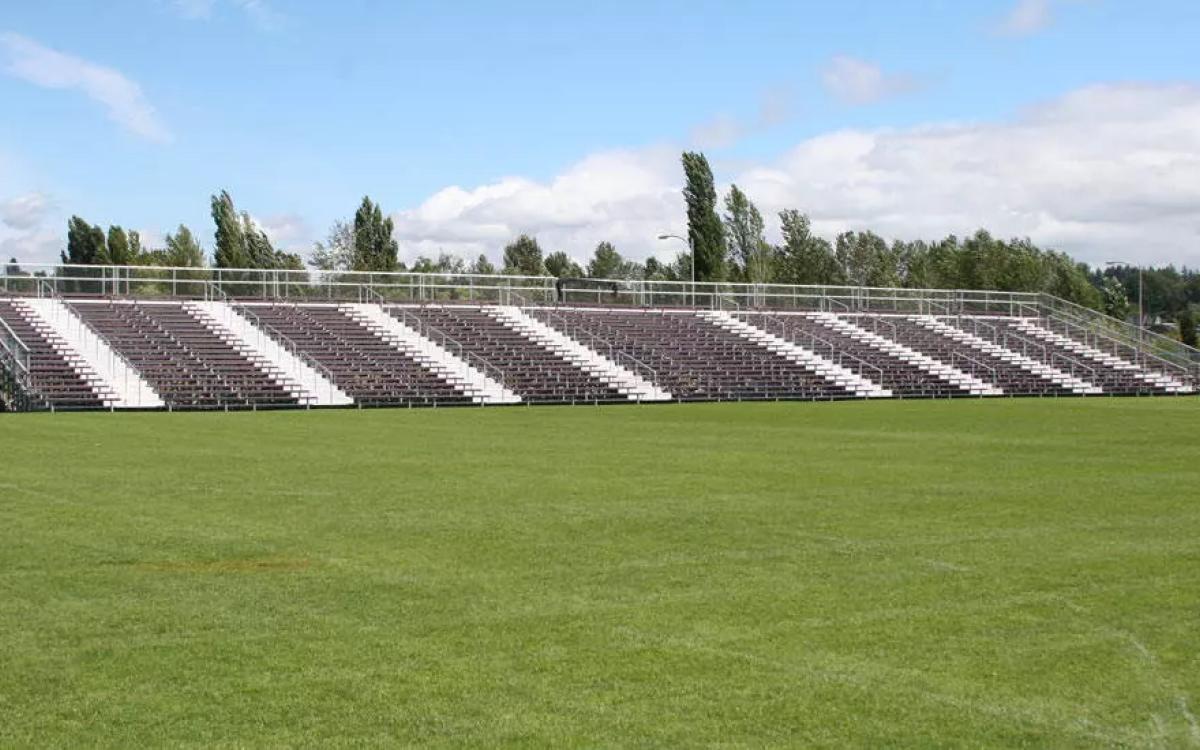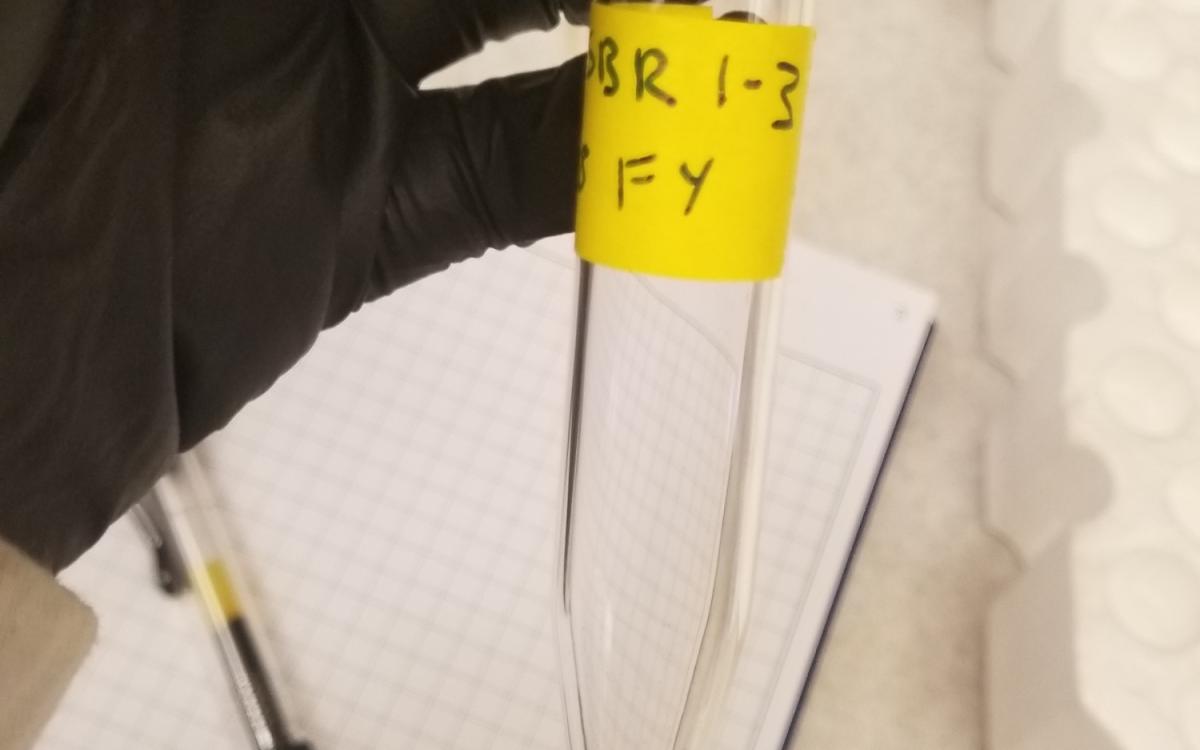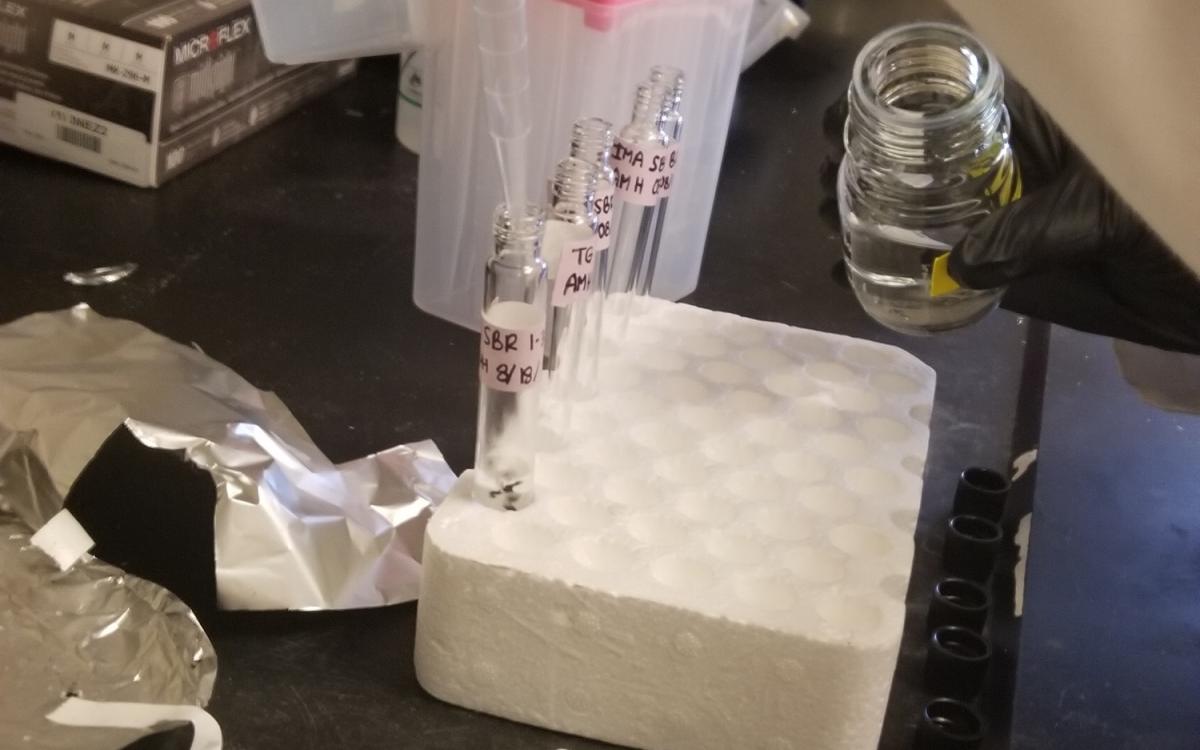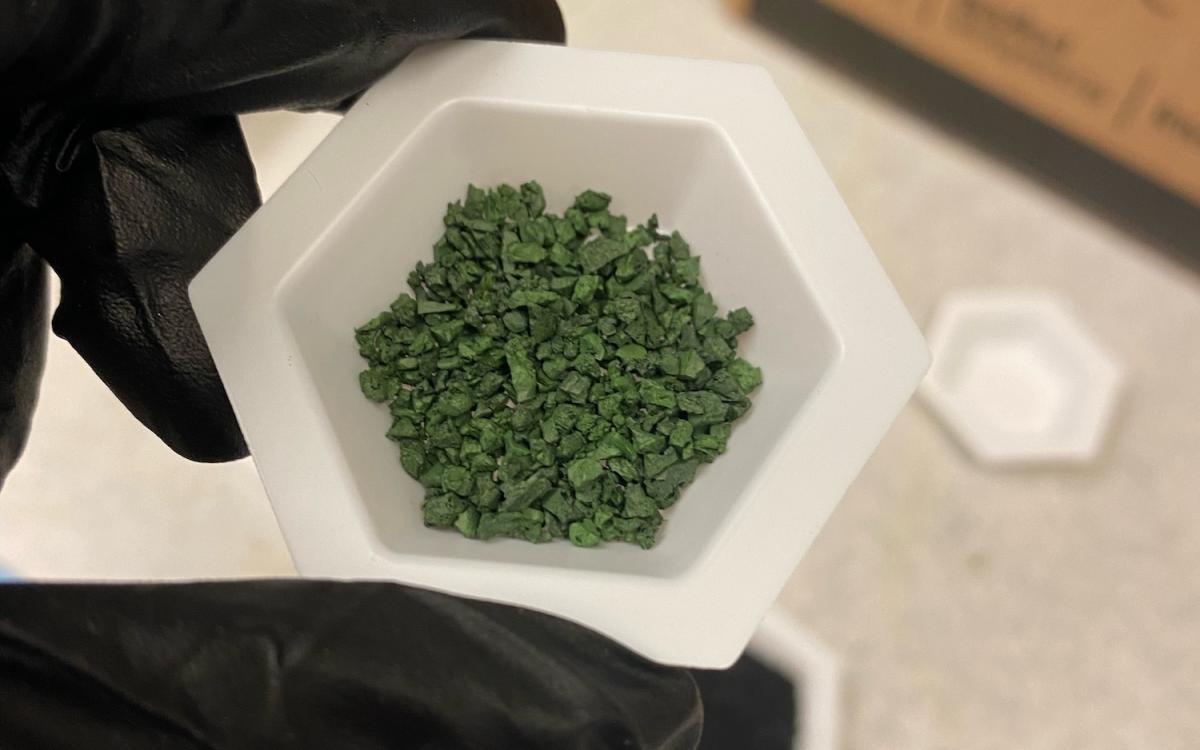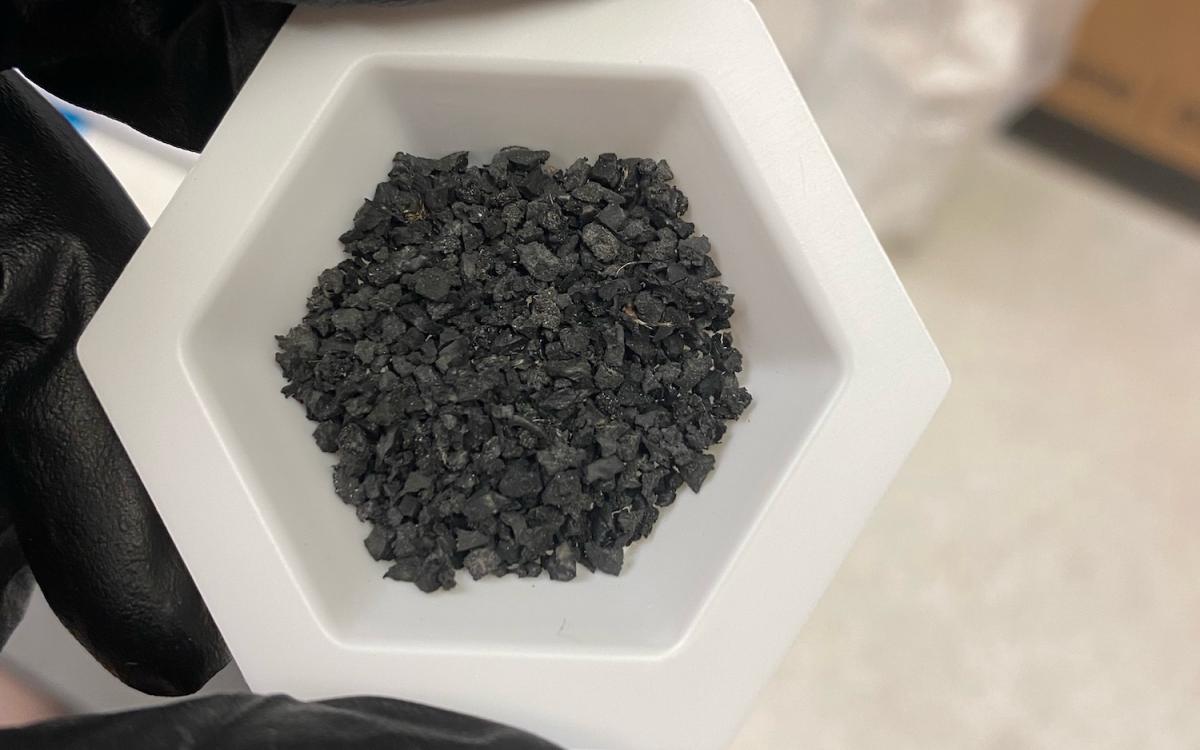At a glance
The University of Washington’s outdoor artificial turf fields, filled with waste tire rubber, may contribute to waterway… Read full summary
- Funding received
- 2023-2024
- Large
- Awarded
- $20,586
- Funding partners
-
- Services and Activities Fee (SAF)
The University of Washington’s outdoor artificial turf fields, filled with waste tire rubber, may contribute to waterway pollution due to 6PPD-quinone, a highly toxic tire rubber additive that severely impacts aquatic species, including salmon. This issue holds environmental, cultural, and societal significance, particularly for Native American tribes whose cultural heritage is deeply tied to salmon and regional ecosystems.
This student-led, two-phase project will assess the environmental impact of UW’s turf fields. Phase I will focus on sampling and feasibility studies to measure 6PPD-quinone leaching and explore alternative infill options. If successful, Phase II will involve full-scale monitoring, testing solutions, and raising awareness to guide sustainable practices on campus.
In recent decades, the prevalence of artificial turf fields have increased drastically. The University of Washington has installed numerous outdoor turf fields to benefit student health and well-being and create surfaces where students can train and recreate in all weather. However, the installation of fields filled with waste tire rubber may be negatively impacting aquatic life in nearby waterways. Recently, 6PPD-quinone (an ozone transformation product (TP) from a common tire rubber additive, 6PPD) was found to be very highly toxic to aquatic organisms, including coho salmon, chinook salmon, steelhead salmon. In fact, 6PPD-quinone is acutely toxic to coho salmon at extremely low concentrations (95 ng/L), placing 6PPD-quinone in the top five acutely toxic compounds to aquatic organisms.
While the environmental impact alone makes the investigation of 6PPD-quinone (and related PPD compounds) pressing, there are important cultural, financial and societal impacts of its release into the environment that are extremely relevant for a public university on indigenous lands to study and prioritize. Native American tribes in the region have deeply rooted environmental and cultural relationships with the land that are closely tied to both water and aquatic species, namely salmon. Therefore, the monitoring and reduction of 6PPD-quinone release on campus is both of environmental and social significance for our local and broader communities.
Emerging research over the last two years has focused on the impacts of tire wear particles from road runoff on receiving bodies of water, but little research has been conducted to determine the impacts of runoff from turf fields filled with waste tire rubber. Herein we propose a student-led, two-phase project to monitor the impact of UW turf fields on water quality and to develop solutions with interested stakeholders. This project will start with a feasibility study, and if the feasibility study is successful, a full scale monitoring project and evaluation of potential alternatives or treatments will follow.
Goals for Phase I (Feasibility Study):
- Collect turf infill samples from all five outdoor fields on UW Seattle campus.
- Identify catch basins and outflows from turf field runoff for sampling.
- Conduct bench-top maximum and environmentally relevant leaching studies on turf infill to determine potential leaching mass of 6PPD-quinone (and other antidegradant TPs).
- Develop a sampling timeline and procedure for Phase II.
- Identify infill alternatives or treatment options to assess in Phase II with the input of stakeholders.
- Raise local awareness of the ecological and societal issues derived from 6PPD-quinone.
- Conduct a perception study of how athletes, community groups, facilities, and staff perceive the different treatment or product replacement options.
Tentative Goals for Phase II:
- Collect samples from previously identified catch basins during storm events throughout the rainy season (October-March).
- Test alternative infill options for 6PPD-quinone leaching with bench-top studies to generate a list of product replacement options for facilities.
- Evaluate potential treatment options for future studies (i.e. retention basin under Husky stadium or sorbent media filters).
- Submit monitoring results for publication.
Alanna Hildebrandt
Project lead
- hilde210@uw.edu
- Affiliation
- Student
Jessica Ray
Team member
- jessray@uw.edu
- Affiliation
- Faculty
Each year since 1972, Lake Washington Salmon have been counted as they pass through the Ballard Locks by the Washington Department of Fish and Wildlife and the Muckleshoot Indian Tribal Staff. Salmon runs through the Locks were once abundant with hundreds of thousands of salmon migrating each year. Now the salmon run population is down to tens of thousands in recent years with a small fraction traveling through Lake Washington to Cedar River each fall to spawn. There are many factors affecting local salmon populations from warming waters to increasing predator populations, but this doesn't fully account for the severely decreasing population. One more piece of the puzzle was discovered in 2021 when researchers identified a tire-derived contaminant responsible for acute toxicity to coho salmon: N-(1,3-dimethylbutyl)-N'-phenyl-p-phenylenediamine-quinone (6PPD-quinone). 6PPD-quinone is classified as a very highly toxic pollutant to aquatic organisms, and many salmonid species (including coho, chinook, and steelhead salmon) are susceptible to acute toxicity from concentrations found in urban runoff. Salmon are of great ecological and cultural importance to this region, and their extinction would lead to the end of a way of life.
The University of Washington (UW) campus was built on the lands of the Duwamish, Squamish, Tulalip, Muckleshoot, and Coast Salish People. Today this land holds multiple turf fields filled with rubber derived from waste tires which drain into Union Bay, a part of Lake Washington. While these facilities provide important services, these fields pose a threat to environmental health and may be furthering the rapid decline in salmon populations. Most research has focused on the impact of tire wear particles generated on roadways; therefore, the impact of turf fields on the water quality and salmon populations is unknown.
Due to the recent discovery of 6PPD-quinone as an acute toxicant, there are significant knowledge gaps that exist, especially in regard to the impact of turf fields on water quality. Projects on this topic have yet to be externally funded, and research projects rarely consider stakeholder priorities or feedback. This project seeks to investigate the impact of turf fields on water quality and understand mitigation options (i.e. product replacement and/or treatment) that would be accepted by project stakeholders and could be implemented on campus. This knowledge will help keep the University of Washington at the forefront of sustainability and leadership. This project has focused on CSF funding for three reasons:
- The unique location of the turf fields near a waterway of historic salmon spawning migration.
- The presence of retention basins under Husky Stadium that may treat the runoff before it enters Union Bay.
- The opportunity to work with interested stakeholders to develop realistic solutions.
We are proposing a student-led, two-phase project to monitor the impact of UW turf fields on water quality and to begin developing potential solutions with interested stakeholders. This project will start with a feasibility study, and if the feasibility study is successful, a full-scale monitoring project and evaluation of potential alternatives or treatments will follow.
Goals for Phase I (Feasibility Study):
- Collect turf infill samples from all outdoor fields on UW Seattle campus.
- Conduct bench-top maximum and environmentally relevant leaching studies on rubber turf infill to quantitatively determine potential 6PPD-quinone concentrations.
- Work with UW facilities to identify catch basins and outflows from turf field runoff for sampling.
- Generate a comprehensive report on the location, composition, and drainage of all outdoor turf fields on UW Seattle campus.
- Develop a sampling timeline and procedure for Phase II.
- Summarize stakeholder views and propose a project direction (i.e. product replacement and/or treatment) for Phase II.
- Raise local awareness of the ecological and societal issues derived from 6PPD-quinone.
Tentative Goals for Phase II:
- Collect samples from previously identified catch basins during storm events throughout the rainy season (October-March).
- Test alternative infill options with bench-top studies to generate a list of product replacement options for facilities when considering routine replacement of surfaces or new installations.
- Evaluate potential treatment options (e.g. retention basin or sorbent media filters).
- Submit year-round stormwater monitoring results for publication.
- Conduct a perception study of how athletes, community groups, facilities, and staff perceive the different treatment or product replacement options.
- Engage with students and the broader community by speaking in classes and at symposiums accessible to the public (e.g.“The Living Breath of wǝɫǝbʔaltxʷ: Indigenous Foods and Ecological Knowledge Symposium” at the University of Washington).
As a Doctoral student in Civil and Environmental Engineering (CEE), I will lead this project. I will be advised by my faculty advisor Dr. Jessica Ray (UW Seattle CEE); my co-advisor Dr. Ed Kolodziej (UW Seattle CEE and UW Tacoma Sciences and Mathematics); and my thesis committee member Dr. Michael Dodd (UW Seattle CEE). Phase I of this project will include two paid UW Seattle undergraduate students to help with research and outreach. Ideally, we will partner with student-athletes who regularly participate in training on the field surfaces under investigation
This project plans to engage multiple stakeholders, including students throughout campus (particularly student-athletes), UW staff who manage turf facilities and purchasing, faculty with experience in environmental water chemistry research, Seattle and Pacific Northwest Communities especially indigenous communities, and researchers in Environmental Engineering. This education and outreach is important, especially for students who will go on to careers in environmental sectors and sports administration, so they can better understand the impacts of field installations and promote more sustainable and eco-friendly fields.
Phase I of this project will take place over 4 months during Spring and Summer 2024 (see timeline). For Phase I, I am requesting $20,000 to support graduate student salary/tuition and benefits, two hourly undergraduate students (6-7 hours a week for approximately two quarters), chemicals, sampling supplies, lab consumables, organic contaminant analyses, and crumb rubber procurement (see budget).
Request amount and budget
How the project will react to funding reductions
The primary goals of the feasibility study are to: characterize the field drainage systems of outdoor turf fields; collect turf infill samples from each outdoor turf field; evaluate samples of rubber infill to determine maximum and environmentally relevant leaching; and, to understand the perspectives and goals for stakeholders for Phase II of the study. Working with the UW engineering services staff to understand the field drainage is a primary priority in the Phase I feasibility study. Understanding the field drainage layouts and visiting the catch basins is imperative for determining the feasibility of the stormwater collection in Phase II. This portion of the study should not be significantly impacted by a cut in funding, as it relies primarily on the time of the project lead and Engineering Services staff. The methods for field sampling and analytical sample processing for 6PPD-quinone have already been developed to test the impacts of tire wear particles in road runoff, so we are confident that we could determine the concentration of 6PPD-quinone in stormwater runoff from the turf fields in Phase II of the project with knowledge and planning of stormwater sampling locations. The collection of turf infill from each field should be relatively straightforward and again not require many supplies. We plan to utilize student volunteers to provide field sampling opportunities for students. This portion of the project is one of the ways we hope to engage with students and achieve the educational and outreach objectives of the study. This portion of the project is a high priority and should not require a significant portion of the funding to complete. The lab based extractions to determine maximum and environmentally relevant leaching of rubber infill require specialized supplies and trained labor. These are the most expensive and time consuming portion of the study, and as a result the extractions would likely be the first thing to get cut (partially or fully cut) if funding is reduced. These extractions are critical for estimating the amount 6PPD-quinone released from each infill type. Because the data is needed to compare infill types, the extractions would need to be pushed back to Phase II of the study. We plan to hire and train undergraduate researchers to conduct rubber infill extractions, which means a cut in funding would reduce some of the in-depth lab based student involvement we planned for Phase I. However, the experiences would still exist in Phase II of the study. It is important to note that we would like to complete lab work during the feasibility study to generate initial data for our Phase II proposal, and to prevent overloading the lab space, lab staff, and analytical instrumentation during Phase II. With a reduction in funding we likely would still be able to spend time engaging with interested stakeholders and understanding future directions of this project. As this again primarily requires time and does not require specialized supplies or training.
Plans for financial longevity
If this project is awarded it will generate data and findings that can stand alone and do not require long term management and maintenance. That being said, there are many unknowns around the emerging contaminant 6PPD-quinone and related PPD TPs which require significant research. Significantly more environmental modeling needs to be conducted, and best practice methods and/or treatment methods need to be developed to mitigate impacts. The preliminary data collected during this two-phase project will be used to seed larger, external proposals submitted to the National Science Foundation and the National Institute of Environmental Health and Sciences program. I have already begun developing a network of mentors and advisors to aid in the success of this project and future projects, including Prof. Ray, Prof. Kolodziej, and Prof. Dodd. We plan to continue collaborating with the campus groups supporting this project (UW Athletics, Engineering Services, and Recreation) as new developments in future projects emerge.
Further my advisor Prof. Kolodziej has collaborative projects funded by the Washington State Department of Ecology addressing 6PPD-quinone impacts and sorption. The Washington State Department of Ecology product replacement division is interested in the impacts of rubber turf infill on the environment). We may be able to work with these contacts to conduct follow up studies or help draft policies and/or regulations for turf infill and for 6PPD-quinone, and PPD-quinones more generally.
There are multiple opportunities for additional funding if this project indicates turf fields need to be investigated further. Additionally, if the stakeholders in this project identify treatment options as the best route to pursue, there are on-campus funding options to create technologies for removal, such as Co-Motion funding, which our lab has previously received to develop selective sorbents for other emerging organic contaminants.
Problem statement
Since 1972, Lake Washington Salmon have been counted each year as they pass through the Ballard Locks by the Washington Department of Fish and Wildlife and the Muckleshoot Indian Tribal Staff. Salmon runs through the Locks were once abundant with hundreds of thousands of salmon migrating each year. Now the salmon run population is down to tens of thousands in recent years with a small fraction traveling to Cedar River each fall to spawn. There are many factors affecting local salmon populations from warming waters to increasing predator populations, but this doesn't fully account for the severely decreasing population. In 2021, researchers in my co-advisor's lab identified a tire-derived roadway contaminant that is responsible for acute toxicity to coho salmon: 6PPD-quinone. Studies examining the environmental effects of this compound suggest that other salmonid species (in addition to coho) are also sensitive to 6PPD-quinone in urban stormwater runoff. Salmon are a keystone species in the Pacific Northwest–particularly for Indigenous peoples' economical and cultural practices.
The University of Washington campus was built on the lands of the Duwamish, Squamish, Tulalip, Muckleshoot, and Coast Salish People. On this land now exist multiple turf fields filled with rubber derived from waste tires which drain into Union Bay, a part of Lake Washington. These fields, as well as other athletic fields, may be furthering the rapid decline in salmon populations. Most research has focused on the impact of tire wear particles generated on roadways; therefore the impact of turf fields on the water quality and salmon populations is unknown. This project seeks to understand and mitigate 6PPD-quione (and other PPD-quinones) release into runoff flowing into Lake Washington. Characterizing the concentrations of PPD-quinones in the field runoff will help determine the potential impacts of these fields on salmon populations and the need for product replacement or treatment options.
Due to the recent discovery of 6PPD-quinone as an acute toxicant, there are significant knowledge gaps that exist, especially in regards to turf fields. Projects on this topic have yet to be externally funded. This project seeks to investigate the extent to which turf fields impact water quality to lay the groundwork for future product replacement or externally funded projects for characterization, fate and transport, and remediation of PPD-quinones or other PPD derived TPs. This knowledge will help keep the University of Washington at the forefront of sustainability and leadership. This project has focused on CSF funding for three reasons:
- The unique location of the turf fields near a waterway of historic salmon spawning migration.
- The presence of retention basins under Husky stadium that may be treating the runoff before it enters Union Bay.
- The opportunity to work with interested stakeholders to develop realistic solutions.
While this project is research-focused, the project will be conducted by students, including scientists from underrepresented groups and backgrounds. Further this project will help protect salmon and local biodiversity, which are of ecological and cultural importance to the indigenous groups of this land as well as all people of Seattle
Measure the impacts
The ultimate goal of this project is to increase the number of salmon that spawn in Lake Washington annually and reduce aquatic contamination from an emerging class of chemical toxicants (PPD-quinones). However, these goals are affected by multiple factors and are difficult to achieve in a year-long project. Realistically, the impact of the project can be measured by the following:
- Student Involvement:
- Number of students involved directly in the research project.
- Number of students who participate in lab tours.
- Learning outcomes from class visits and public talks.
- Data collection:
- Data on turf field design and components, drainage, and presence of existing treatment options will be collected and compiled.
- Concentrations on 6PPD-quinone (and other PPD-quinones) from maximum and environmentally relevant leaching studies on all existing and potential turf infill options will be generated and tabulated for use by researchers and staff designing facilities.
- Concentrations of 6PPD-quinone (and other PPD-quinones) in runoff from various catch basins will be determined to monitor tire-derived turf infill contaminants entering receiving waterways.
- Specifically, catch basins before and after the retention basins in Husky stadium will be monitored and evaluated as a potential treatment option.
- Idea generation for treatment/prevention options with interested stakeholders:
- We will work with interested parties: UW staff in recreation, athletics, and facilities, student athletes, and indigenous groups to generate a list of treatment/prevention options that would be accepted and likely to be adopted.
- If time permits in Phase II, preliminary treatment options may be tested.
- Publication, outreach, and research articles:
- We will work with UW News or the UW sustainability blog to publish a public article on our work.
- We will present our findings to relevant community groups. Specifically we will apply to “The Living Breath of wǝɫǝbʔaltxʷ: Indigenous Foods and Ecological Knowledge Symposium” at the University of Washington to present our work in connection with the impact of turf infill to salmon and indigenous communities.
- We will publish one to two research articles detailing the findings on the turf infill leachate concentrations and the concentrations of field runoff in catchment basins in peer-reviewed journals.
- After project completion, we will work with student athletes to create signage near Husky stadium that details the sustainable impacts of this CSF project.
Education and outreach goals
This project plans to engage multiple stakeholders, including students throughout campus (particularly student athletes), UW staff in charge of managing turf facilities and purchasing, faculty with experience in environmental water chemistry research, Seattle and Pacific Northwest Communities especially indigenous communities, and researchers in Environmental Engineering. This education and outreach is important, especially for students who will go on to careers in environmental sectors and sports administration, so they can better understand the impacts of field installations and promote more sustainable and eco-friendly alternatives. Furthermore, publishing our work will help disseminate the findings of this study to broader audiences, and help advance and direct the emerging research on 6PPD-quinone, other PPD-quinones, and other PPD derived transformation products (TPs). Throughout both phases of the project, education and outreach on the impact of 6PPD-quinone will be a top priority. Some of the education and outreach opportunities for this project are included below and will span both Phase I and Phase II.
- We will connect with the organization Student Athletes of UW for Sustainability (SAUWS). Through this organization and the student athlete network, we plan to raise awareness of our project and garner student athlete volunteers for turf and water sample collection.
- We will consult with Graduate and Professional Student Senate (GPSS) to guide project directions and ensure generation of complementary and high-impact research on 6PPD-quinone (and other PPD-quinones).
- We plan to offer opportunities for undergraduate research assistants throughout both phases of the project, giving opportunities to train emerging environmental scientists and athletic managers with the opportunity for co-authorship on project publications.
- Undergraduate research assistant positions will not be limited to STEM students, but will include students interested in product replacement, athletic management, stakeholder perspectives, and community engagement.
- Students from historically marginalized communities will be recruited for student research and volunteer positions for each phase of the project through advertised positions.
- We plan to host an undergraduate student from the Heritage University Engagement Achievement & Graduation for Low-income Students (EAGLES) program or Louis and Stokes Alliance for Minority participation (LSAMP) to conduct summer research during each phase of the project. As mentioned before, Heritage University is a minority serving institution with large populations of indigenous students. This collaboration will allow us to make connections and incorporate research perspectives from indigenous researchers.
- Student research assistants, volunteers, SAUWS members, and GPSS members will be invited on a field trip in Fall 2024 to learn more about the Center for Urban Waters (CUW) where the UW research team first identified and detected 6PPD-quinone using advanced analytical instrumentation.
- We plan to give talks in relevant courses (e.g., CEE 598 Stormwater Management and Treatment) within the department of Civil and Environmental Engineering.
- We plan to apply to “The Living Breath of wǝɫǝbʔaltxʷ: Indigenous Foods and Ecological Knowledge Symposium” at the University of Washington during or after completion of this project to present our work in connection with the impact of turf infill to salmon and indigenous communities.
- We will conduct structured interviews with UW recreation and athletics to understand the purchasing decisions and factors that influence field materials, installation, and treatment.
- One barrier with environmental efforts that require product replacement are that product recommendations may not meet performance requirements or preferences. By working with stakeholders (including student athletes and program managers), we can ensure that potential alternatives are feasible.
- Further, we can work with stakeholders to develop replacement or treatment options that are user friendly and favorable, so treatment or product replacement will be implemented without enforcement.
- We plan to interview Muckleshoot Indian Tribal Staff to further incorporate indigenous perspectives into the project
Student involvement
The involvement of undergraduate researchers, athletes and students is extremely important to the success of our proposed work. Furthermore, including students in our work will provide an invaluable learning experience to their undergraduate education. It is important to our project to incorporate future environmental scientists who will lead future directions in environmental research, and future sports administrators who will make decisions regarding the wellbeing of athletes and sports facilities (e.g., field surfaces). This project will be managed by a graduate student lead, employ multiple undergraduate student research assistants throughout both phases, open opportunities for graduate and undergraduate students to participate in independent study, and present opportunities for student groups and student volunteers to participate in research or perception studies.
As the graduate student lead, I already have experience mentoring students. Specifically I have been working with a chemical engineering undergraduate student researcher for the last year and have been mentoring a Masters student researcher for two quarters. This project will allow me to continue mentoring students in a research setting and allow me to collaborate with students on field work and stakeholder studies. Our research lab values diversity and inclusion. The lab already has connections with programs that help to place historically marginalized students in research settings, and actively seeks researchers from diverse backgrounds. So recruiting students and volunteers would continue in this vein.
This campus sustainability project would provide urban field work opportunities for students and allow students to be directly involved in data collection and sample processing. Often field work experiences require a significant time commitment and planning for students to participate, and are usually difficult to schedule around classes and other obligations, but an on campus research opportunity for students to sample turf or collect stormwater will eliminate these barriers, especially for extremely busy student athletes. Further, the opportunity for student athletes to learn about and understand how their field surfaces are designed and impact the surrounding environment and biodiversity of the region is an invaluable connection. This project is transdisciplinary and would not require significant research or STEM background for interested students to get involved in field work or stakeholder perspective studies. The project also provides paid and course credit opportunities for interested students to develop research skills to prepare them for graduate school or future careers.
The project lead and sponsoring department are committed to offering opportunities for historically marginalized students to participate in the project in accordance with their interests, backgrounds, and capabilities. With a special emphasis on incorporating students from indigenous communities. Below are some of the proposed student positions that will be created with each phase of the project:
Phase I (Feasibility Study):
- Funding for two undergraduate students at 6-7 hours per week. One student will primarily do analytical sample processing. The other student will lead the interviews and surveys with interested stakeholders and connect with communities on and off campus. Both students will be co-authors on relevant publications.
- We plan to host an undergraduate student from the Heritage University Engagement Achievement & Graduation for Low-income Students (EAGLES) program or Louis and Stokes Alliance for Minority participation (LSAMP) to conduct summer research. Heritage University is a minority serving institution located on the Yakama Indian Reservation with large populations of indigenous students. Faculty advisor Jessica Ray has hosted EAGLES students previously, and we will continue working with students from indigenous and/or minority communities for the CSF project given the important adverse toxicological impact of tire rubber product leachate to the salmon population and the cultural significance of salmon to tribal communities.
- We plan to partner with Student Athletes of UW for Sustainability (SAUWS) to do outreach and recruit volunteers.
- We will work with SAUWS to understand the perspectives of student athletes in regards to turf surfaces.
- We plan to host a tour of the facilities at the Center for Urban Waters in Fall 2024 to show any interested student volunteers, student athletes, or undergraduate researchers the instrumentation used for this project.
Phase II (Monitoring and evaluation of alternatives or treatments):
- For Phase II, we will have two paid undergraduate student research positions available. Each position will be for 8 hours a week, and students will contribute to analytical processing of the stormwater samples and any alternative infill options we wish to explore. These positions will allow students to gain direct lab experience and understand the work that goes into environmental sample processing. These students will have the opportunity to participate as co-authors on publications.
- There will also be opportunities for students to participate in the project by enrolling in independent study course credits or volunteering. This would be a great opportunity for students who would like to develop research skills or students in other disciplines who would like to conduct perception studies with interested stakeholders.
- Student researchers would ideally participate from impacted populations, such as student athletes and indigenous students. These positions will not require significant time commitment from students.
